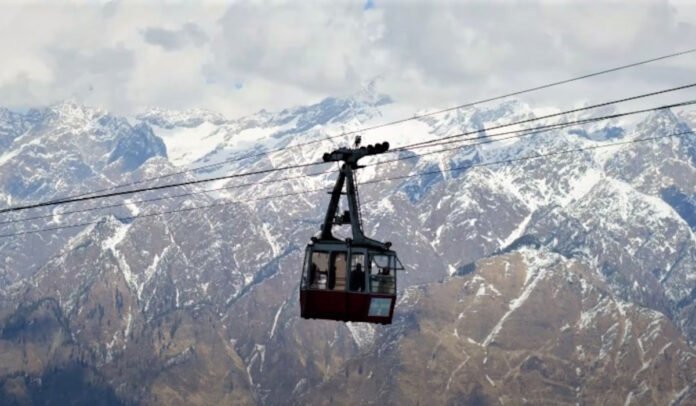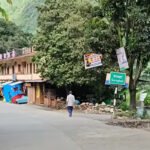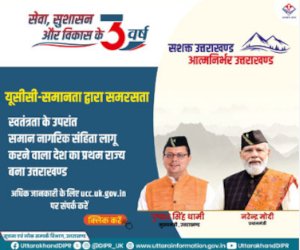For centuries, pilgrims and travellers to Uttarakhand’s sacred shrines and lofty valleys have braved steep climbs, unpredictable weather, and unforgiving mountain paths. On Tuesday, the state took a decisive step towards rewriting that experience. By signing an agreement with the National Highways Logistics Management Limited (NHLML) to develop ropeways to Kedarnath and Hemkund Sahib under the Parvatmala Project, the government signalled a new chapter in how people will journey through the Himalayas. Every year, tens of thousands of devotees and tourists throng the state’s pristine locales, but for many the treacherous routes remain out of reach. Thus, ropeways promise to bridge that gap —combining safety with speed, and tradition with technology. The signing of the MoU is not just a bureaucratic formality; it is the perfect moment to look back at the Parvatmala Pariyojana, launched in 2022, and explore how it is set to transform mountain travel across India in general and especially across the Devbhoomi.
Parvatmala Takes Shape
It all started with Union Finance Minister Nirmala Sitharaman Union Budget for 2022–23, where one announcement stood out for the country’s hill states: the launch of Parvatmala Pariyojana, a national ropeways development programme. Designed to improve mobility in difficult terrains, the programme envisions building more than 200 ropeway projects across 1,200 kilometres by 2030.
For India’s fragile Himalayan regions, where road construction is both expensive and ecologically damaging, ropeways promise a modern, eco-friendly alternative. They use minimal land, generate fewer emissions, and provide quick and safe access across steep valleys and river gorges.
Prime Minister Modi’s Vision
At the launch of the scheme, Prime Minister Narendra Modi underlined its national importance. He said:
“For the first time in the country, the Parvatmala scheme is being started for areas such as Himachal Pradesh, Uttarakhand, Jammu and Kashmir and the North-East. This scheme will create a modern system of transportation and connectivity on the mountains. It will also strengthen the border villages of our country, which need to be vibrant, and which is also necessary for the security of the country.”
For Uttarakhand, a state that sees millions of pilgrims and tourists every year, Parvatmala has quickly moved from vision to reality.
Kedarnath and Hemkund Ropeways: Flagship Projects
Uttarakhand’s entry into Parvatmala is anchored by two mega projects approved by the Union Cabinet:
-
Sonprayag to Kedarnath Ropeway
-
Length: 12.9 km
-
Cost: ₹4,081 crore
-
Capacity: 1,800 passengers per hour
-
Travel Time: reduced from 8–9 hours on foot to just 36 minutes
-
-
Govindghat to Hemkund Sahib Ropeway
-
Length: 12.4 km
-
Cost: ₹2,730 crore
-
Capacity: 1,100 passengers per hour
-
Travel Time: reduced from 5–6 hours of trek to around 45 minutes
-
Both ropeways are being built under a Public–Private Partnership model with equity participation: 51% by National Highways Logistics Management Limited (NHLML), a special purpose vehicle of NHAI, and 49% by the Uttarakhand government. Importantly, 90% of the revenue generated will be reinvested into Uttarakhand’s tourism, mobility, and infrastructure development.
Why Ropeways Matter in Uttarakhand
The Himalayan terrain presents unique challenges. Steep gradients, landslide-prone stretches, narrow passes, and harsh weather often disrupt traditional road and trek routes. During peak pilgrimage seasons, thousands of visitors struggle to reach shrines like Kedarnath and Hemkund Sahib, leading to long queues, delays, and sometimes unsafe conditions.
Ropeways provide:
-
Eco-Friendly Mobility: They require minimal land, avoiding the deforestation linked with road projects.
-
Time Efficiency: Travel times are cut by more than 80%, making high-altitude shrines accessible to children, the elderly, and differently-abled devotees.
-
Year-Round Access: Ropeways can operate safely even during months when roads are blocked due to heavy snowfall or rains.
-
Tourism Boost: Quick access can multiply tourist numbers, while reducing pressure on narrow mountain paths.
Economic and Social Impact
The Kedarnath ropeway alone is expected to serve over 3.6 million pilgrims annually, while Hemkund Sahib’s ropeway will cater to around 1.4 million visitors. Together, they could redefine the way people experience religious and adventure tourism in Uttarakhand.
But beyond pilgrims, the benefits extend directly to local communities:
-
Jobs: From construction to operations, hundreds of local youth will find employment. Ropeway stations will create opportunities in security, maintenance, hospitality, and transport.
-
Entrepreneurship: Small businesses—cafés, handicraft stalls, and homestays—are likely to flourish near ropeway terminals.
-
Farmer Advantage: Improved access means local produce like apples, pears, and spices can reach markets faster.
-
Revenue Recycling: With 90% reinvestment mandated, the state’s tourism and mobility ecosystem will see sustained improvements.
Uttarakhand’s Larger Connectivity Vision
Chief Minister Pushkar Singh Dhami has consistently highlighted ropeways as part of a broader push to strengthen state connectivity. Alongside the Char Dham All-Weather Road, the Delhi–Dehradun elevated expressway, and railway projects like the Rishikesh–Karnaprayag line, ropeways form the “third leg” of Uttarakhand’s mobility model—rail, road, and ropeway.
Together, these initiatives are expected to cut travel time dramatically, improve safety, and attract more domestic and international tourists.
Tourism Secretary Dhiraj Singh Garbyal recently noted that the ropeways will not only “halve travel times but also make pilgrimages far safer and accessible to all age groups.”
Ropeways as a Green Solution
One of the strongest arguments in favour of ropeways is their sustainability quotient. Traditional road-building in fragile hill terrain requires extensive tree cutting, blasting of slopes, and drainage alteration, often worsening landslide risks. Ropeways, by contrast:
-
Use pylons placed at intervals, keeping most of the land untouched.
-
Emit far less carbon compared to thousands of vehicles moving uphill.
-
Cause minimal noise and dust pollution.
-
Operate reliably with renewable energy inputs, especially hydropower, which Uttarakhand already produces in abundance.
For a state marketing itself as the land of the Himalayas and the origin of sacred rivers, adopting eco-sensitive mobility solutions aligns with both branding and responsibility.
Challenges on the Horizon
While the promise is undeniable, ropeway projects also bring challenges:
-
High Initial Costs: With investments crossing ₹6,800 crore for Kedarnath and Hemkund alone, financial sustainability must be ensured.
-
Technology and Safety: Systems like 3S gondolas are advanced but require world-class operations and constant monitoring.
-
Community Inclusion: Local populations must feel they are beneficiaries, not just bystanders, to prevent social resistance.
-
Environmental Clearances: Even minimal-impact projects in sensitive ecosystems require rigorous safeguards.
The state government has indicated it will address these through strict oversight, transparent contracts, and continuous consultation with local communities.
Beyond Pilgrimage: Expanding the Ropeway Network
Though Kedarnath and Hemkund are the flagship projects, Uttarakhand is already exploring more ropeway corridors.
Such expansion would diversify Uttarakhand’s tourism portfolio beyond religious travel, appealing to adventure seekers, cultural tourists, and international visitors.
PM Modi’s “Vibrant Villages” Link
Parvatmala also ties into the Prime Minister’s broader vision of strengthening India’s border villages. Many of Uttarakhand’s frontier hamlets face depopulation as residents migrate in search of jobs and better access. Ropeways, by improving connectivity, could play a vital role in reversing this trend—keeping villages vibrant, populated, and economically active.
As PM Modi emphasised: “This scheme will strengthen the border villages of our country, which need to be vibrant, and which is also necessary for the security of the country.”
Looking Ahead: Uttarakhand as a Model State
The coming decade could see Uttarakhand emerge as a model for ropeway-based mobility in the Himalayas. The combination of high-capacity ropeways, sustainable tourism, and reinvestment in local infrastructure provides a template that other states can emulate.
If implemented successfully, ropeways will:
-
Transform pilgrim journeys into comfortable, time-efficient experiences.
-
Provide locals with new livelihood opportunities.
-
Reduce vehicular load on fragile mountain roads.
-
Position Uttarakhand as both a spiritual and eco-tourism hub.
In the long run, the state could brand itself not just as the land of Char Dham but also as India’s “Ropeway Capital”, showcasing how modern engineering and traditional heritage can complement each other.
Conclusion
Parvatmala is more than an infrastructure project—it is a statement about how India sees the future of its mountains. For Uttarakhand, it represents a chance to combine pilgrimage, tourism, ecology, and livelihoods into a single development pathway.
From Kedarnath’s snow-clad shrines to Hemkund’s alpine meadows, ropeways promise to make the Himalayas more accessible without compromising their sanctity. As the first gondolas glide across valleys and rivers, they will carry not just passengers, but also the aspirations of a state determined to balance faith, development, and sustainability.

























